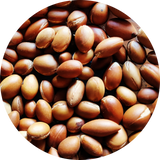History of Argan Oil
It has been used for centuries by Berber women for its many virtues; Argan oil has exceeded the borders of Morocco and sparked worldwide interest for its cosmetic properties and qualities.
The history of the oil of argan has often been confused with the history of Morocco, becoming this the emblem of the lands of the country. Argan oil has passed through the hands of various peoples. One of the first uses that were given to the oil of Argan was to feed the oil lamps; the Phoenicians used it as fuel thanks to the high luminosity that gives off this oil. Later, the Berber people discovered their cosmetic and nutritional virtues and began to incorporate it into their habits of life.

Over the centuries, this oil has been much appreciated by the Berber tribes in Morocco.
Due to its cosmetic properties, the primary use that people gave to Argan oil was as a skin protector from the ultra-dry climate.
At the beginning of the 90's, the tree that gives the fruits of which we extracted the oil of Argan was almost extinct. The demand for other types of crops was gradually replacing the use of this oil, however, due to all the properties beneficial to health and its immense history, in 1999 UNESCO recognized the Argan tree as a world heritage.
When the cosmetic industry discovered the benefits of this oil, it decided to focus on the Maghreb and began to exploit the cultivation of the tree producing other cosmetic products in which Argan oil was one of the active ingredients.

At Thousands of years of age, this tree has been able to survive and adapt to the arid climate of Morocco. Each specimen can reach 10 meters in height, and the life of this prodigy can reach up to 200 years of age. At night it can attract atmospheric moisture to store the water and gradually return part of it to the earth to its roots, which can sometimes sink to 30 meters in search of water to help you pass the stations hot.
When the weather is too extreme, the argan tree drops its leaves to avoid evaporation and enters a state of hibernation that will emerge when the percentage of humidity in the environment increases.
At night it can attract atmospheric moisture to store the water and gradually return part of it to the earth to its roots, which sometimes sink to 30 meters in search of water.
The tree of Argan gives its fruits between May and June. These fruits look like olives but are a little larger and rounder. Within this fruit is the almond in which we extract the oil of argan. The production of argan oil is a complete artisan process and requires considerable work. It is hand collected and then put to dry in the sun.
At Some Moroccan cosmetics, Our Argan oil is produced by pressing the almond and processed without using solvents or heat, which keeps 100% of all the nutrients within the oil.
This age-defying natural oil has now become an international sensation.
While the Argan tree only produces a few kilos of fruit a year, which gives Argan oil the title of "one of the scarcest oils in the world.
Many any A-list celebrities such as Selena Gomez, Eva Mendes, Taylor Swift, Charlize Theron, Madonna, Angelina Jolie, Jennifer Aniston, Scarlett Johansson, personally vouch for and use Cosmetic Argan oil (just to name a few.)
Today Argan oil is especially popular with women who prefer using natural and organic substances on their skin instead of artificial and potentially harmful chemicals.
We at SOME MOROCCAN Cosmetics make sure to treat the majestic Argan tree with great respect; as well as focusing on giving back to the community. Hence why a significant portion of the sales goes towards purchasing school supplies for children in rural Morocco.
We work closely with many local Moroccan businesses to bring you this pure, natural and 100% Fair-trade product.
Yours in beauty,
Some Moroccan Incorporated
